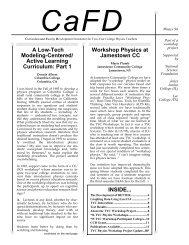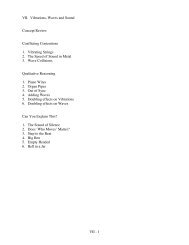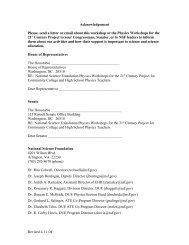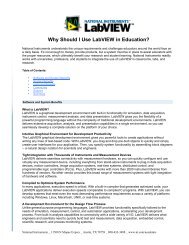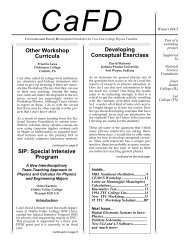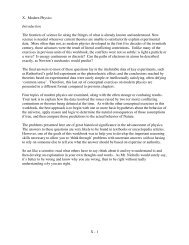III - 1 II. Newton's Laws of Motion Concept Review Warm-Up ...
III - 1 II. Newton's Laws of Motion Concept Review Warm-Up ...
III - 1 II. Newton's Laws of Motion Concept Review Warm-Up ...
You also want an ePaper? Increase the reach of your titles
YUMPU automatically turns print PDFs into web optimized ePapers that Google loves.
Would the spring scale read 0, 10, or 20 Newtons, or something else<br />
Suppose one side had a mass <strong>of</strong> 5 Newtons and the other side had a mass <strong>of</strong> 15 Newtons, so that<br />
the system was accelerating. Now what would be the scale reading (if you could read it while it<br />
accelerated past you)<br />
6. Atwood’s Machine<br />
Like Galileo, Atwood invented a ‘gravity dilution device’, as shown in the picture. Atwood’s<br />
machine consists <strong>of</strong> two masses attached to each other on opposite sides <strong>of</strong> a pulley. The two<br />
masses are able to remain at rest if the two masses are equal (m1 = m2); if the two masses are not<br />
equal, then they will experience an acceleration, with the heavier mass falling and the lighter<br />
mass rising.<br />
m 2<br />
m 1<br />
Suppose we construct an Atwood’s machine by placing 5 masses with a weight <strong>of</strong> 0.1 Newton<br />
each on two identical 0.5 Newton weight hangers, resulting in a total weight <strong>of</strong> 1.0 Newton on<br />
each side <strong>of</strong> pulley.<br />
a. Suppose you tap one <strong>of</strong> the weight hangers under these conditions <strong>of</strong> equal weight, pushing it<br />
downward. What would you observe about the motion <strong>of</strong> the two masses<br />
One 0.1 Newton weight is now transferred from one weight hanger to the other, causing one side<br />
to have a weight <strong>of</strong> 1.1 N and the other to have a weight <strong>of</strong> 0.9 N. When the weight hangers are<br />
let go, the two masses accelerate due to the force difference <strong>of</strong> 0.2 N.<br />
b. If a second 0.1 N weight is transferred from the lighter side to the heavier side, how will the<br />
acceleration <strong>of</strong> the weight hangers compare to the previous situation<br />
Now suppose a force difference <strong>of</strong> 0.2 N is maintained, but an extra 0.5 N <strong>of</strong> weight is added to<br />
both <strong>of</strong> the weight hangers.<br />
c. How will the acceleration <strong>of</strong> the system change compared to the previous case, or will it stay<br />
the same as before<br />
<strong><strong>II</strong>I</strong> - 9



